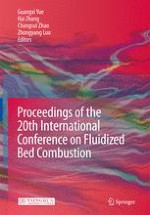2010 | OriginalPaper | Chapter
Sulphation of CaO-Based Sorbent Modified in CO2 Looping Cycles
Authors : Vasilije Manovic, Edward J. Anthony, Davor Loncarevic
Published in: Proceedings of the 20th International Conference on Fluidized Bed Combustion
Publisher: Springer Berlin Heidelberg
Activate our intelligent search to find suitable subject content or patents.
Select sections of text to find matching patents with Artificial Intelligence. powered by
Select sections of text to find additional relevant content using AI-assisted search. powered by
CaO-based looping cycles for CO
2
capture at high temperatures are based on cyclical carbonation of CaO and regeneration of CaCO
3
. The main limitation of natural sorbents is the loss of carrying capacity with increasing numbers of reaction cycles, resulting in spent sorbent ballast. Use of spent sorbent from CO
2
looping cycles for SO
2
capture is a possible solution investigated in this study. Three limestones were investigated: Kelly Rock (Canada), La Blanca (Spain) and Katowice (Poland). Carbonation/calcination cycles were performed in a tube furnace with original limestones and samples thermally pretreated for different times (i.e., sintered). The spent sorbent samples were sulphated in a thermogravimetric analyzer. Changes in the resulting pore structure were then investigated using mercury porosimetry. Final conversions of both spent and pretreated sorbents after longer sulphation times were comparable or higher than those observed for the original sorbents. Maximum sulphation levels strongly depend on sorbent porosity and pore surface area. The shrinkage of sorbent particles during calcination/cycling resulted in a loss of sorbent porosity (≤48%), which corresponds to maximum sulphation levels ∼55% for spent Kelly Rock and Katowice. However, this is ∼10% higher than for the original samples. By contrast, La Blanca limestone had more pronounced particle shrinkage during pretreatment and cycling, leading to lower porosity, <35%, resulting in sulphation conversion of spent samples <30%, significantly lower than for the original sample (45%). These results showed that spent sorbent samples from CO
2
looping cycles can be used as sorbents for SO
2
retention if significant porosity loss does not occur during CO
2
reaction cycles. For spent Kelly Rock and Katowice samples final conversions are determined by the total pore volume available for the bulky CaSO
4
product.
